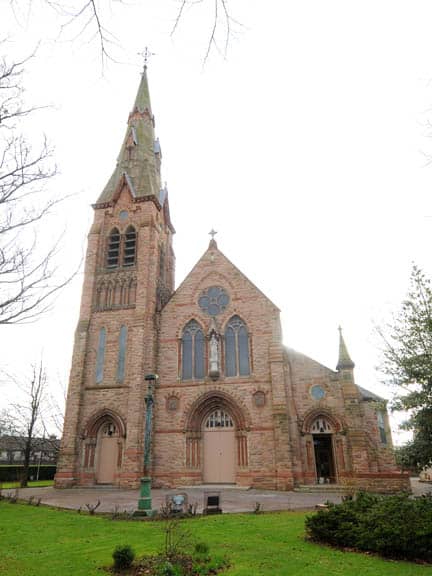
Introduction by Kieran Glennon.
In the immediate aftermath of the violence that erupted in Belfast in August 1969, Citizens’ Defence Committees (CDCs) were formed in many nationalist areas; barricades were hastily erected and patrols of vigilantes armed with clubs were organised to ensure that loyalist mobs, the B Specials and the RUC were all kept at bay. Within days, a co-ordinating group was established to link the individual CDCs, the Central Citizens’ Defence Committee (CCDC); its first chairman was Jim Sullivan, who was also Adjutant of the IRA’s Belfast Brigade.
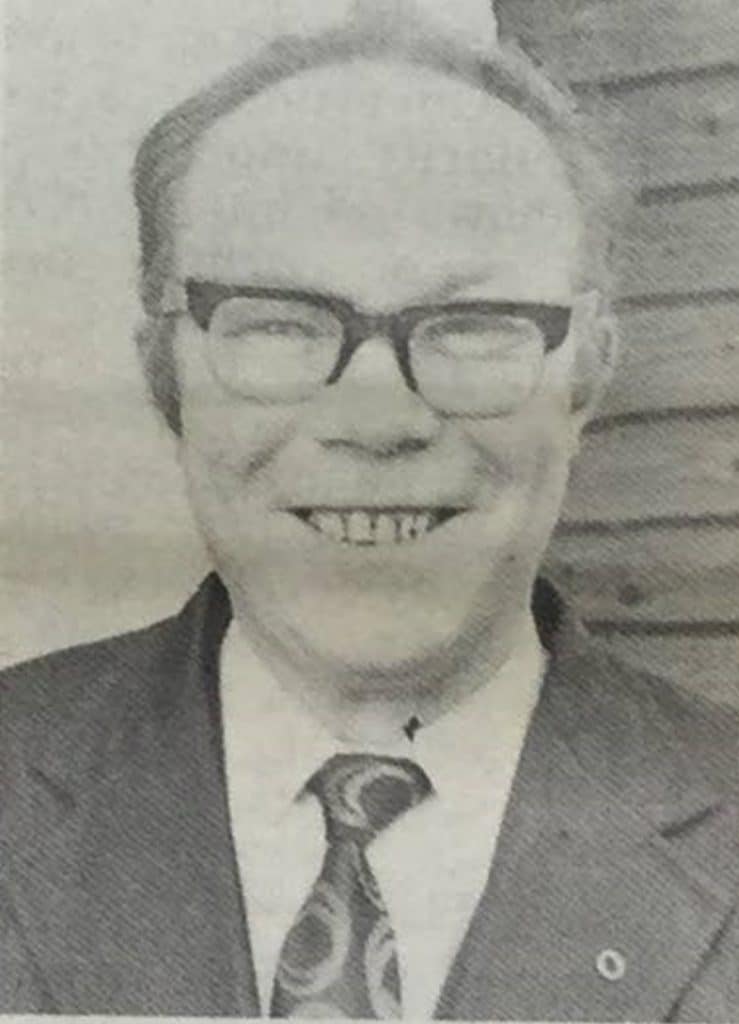
Jim Sullivan, Adjutant of Belfast IRA and first chairman of Central Citizens’ Defence Committee (CCDC)
By early 1970 Sullivan had been deposed and replaced as chairman by Tom Conaty, a fruit and vegetable merchant from west Belfast. Conaty’s closest ally on the CCDC was Canon Pádraig Murphy, the administrator of St Peter’s Cathedral in the Lower Falls. Paddy Devlin MP had remained the CCDC’s secretary since its inception.
Fifty years ago this month at the end of June 1970 the Provisional IRA made their first appearance on the streets of Belfast, in conjunction with armed members of the local CDC, in what came to be known as the Battle of St Matthew’s. In Ballymacarrett in the east of the city, more commonly known today as the Short Strand, three people were killed in the worst night of violence since August 1969.
At that time, Tom Henry – a nom de plume – was self-employed as a researcher and was commissioned by Conaty and Murphy to write a history of St Matthew’s church for the diocese of Down and Connor. Also at that time, Conaty and Murphy were welcome at Army HQ Lisburn as representing the Bishop of Down and Connor, Doctor William Philbin.
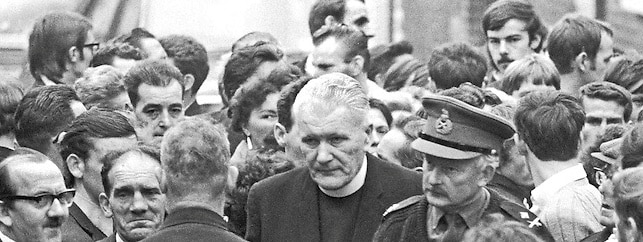
Canon Padraig Murphy and Major General Tony Dyball
Henry was given access to parish records at St Matthew’s as well as written statements from witnesses who were present there during that night. However, despite their central involvement in the battle, Henry did not knowingly interview any members of the IRA or their local auxiliaries. Fearful of the police scrutiny that would inevitably follow the pamphlet’s publication, he took the view that what he didn’t know couldn’t be got out of him, even under torture. So, while there is one reference in his text to “armed defenders”, the initials “IRA” are not mentioned.
Henry completed his pamphlet in April 1971 and concluded that on the night the British Army had failed to honour written agreements given to the Ballymacarrett CDC for the defence of the area if attacked. In view of this conclusion, he believed the pamphlet would not be well received.
This conclusion did not suit Conaty and Murphy. At the time, they were trying to position the CCDC as the spokesmen for moderate nationalists; their efforts to develop a close relationship with Army HQ in Lisburn would receive a frosty response if they were to publish an account of the debacle that was critical of the Army.

Tom Conaty, Chairman of the CCDC: commissioned the pamphlet but its conclusions would have threatened his relationship with British Army HQ, Lisburn.
I have known Tom Henry for many years and know him to be a man of impeccable integrity: he was not about to change his conclusion to suit the positions of Conaty and Murphy. A copy of the manuscript was shown to Henry Kelly, then northern correspondent of the Irish Times whose opinion, as he informed Henry, was that the pamphlet would never see the light of day. That remark turned out to be prophetic.
It is notable that while the confrontation became known as the Battle of St Matthew’s, Henry entitled his pamphlet the “Battle for St Matthew’s”; the distinction is subtle, but probably reflects more closely what happened on the night. Historian Andrew Boyd had a copy of the manuscript and donated it to the Linen Hall Library in Belfast, considering it to be an important historical document. Although it was referenced in the book Belfast and Derry in Revolt, by Simon Prince and Geoffrey Warner, the full text has never before been published.
Included as a prologue, as they form an essential foundation for Henry’s conclusion, are the verbatim texts of the documents supplied by the Army to the Ballymacarrett CDC in September 1969; also included are excerpts from written responses to the Army and RUC by the CDC and their legal advisor. Taken together, these constitute the “Joint Military and Police Security Plan for Ballymacarrett.” Like the pamphlet itself, they have never previously been published.
The early chapters of the pamphlet provide context for the events of June 1970. Chapter 3 outlines previous attacks made on St Matthew’s in the course of the pogrom of 1920-22. Chapter 4 recounts the opposition to the planned building of a Catholic church elsewhere in east Belfast in the 1930s, illustrating that sectarian hatred was directed, not just at St Matthew’s in particular, but at Catholic churches in general. Chapter 5 details correspondence between the Bishop of Down and Connor, William Philbin, and the chairman of the Sirocco Works at Bridge End, near St Matthew’s, concerning the extent of religious discrimination in employment at the firm – overturning such discrimination was one of the key objectives of the Civil Rights movement, to which unionism took such violent exception.
What happened during the Battle for St Matthew’s undoubtedly flowed from what had happened before – but what ultimately transpired was not inevitable.
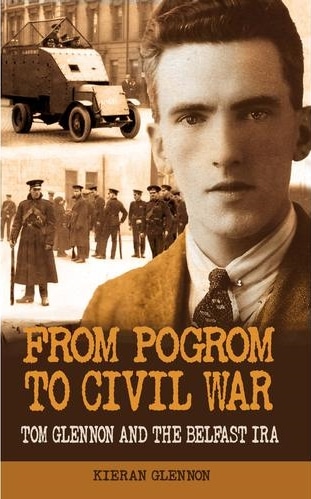
Kieran Glennon is the author of From Pogrom to Civil War, Tom Glennon and the Belfast IRA. Although he is not from the area, two of his great grandparents were married in St Matthew’s. In 1920, his grandfather, as a member of the IRA, did picket duty at the church to protect it from sectarian attack.
Prologue: September 1969
On 12th September 1969, the Ballymacarrett Citizens’ Defence Committee (CDC) met with the British Army and RUC to discuss security in the area; the next day, the Army wrote to the CDC as follows, confirming what had been agreed:
“ RESTRICTED
2 GREN GDS
BFPO 801
13 September 1969
HQ 39 Bde
Lisburn
PROPOSED JOINT MILITARY AND POLICE SECURITY PLAN FOR BALLYMACARRETT DISTRICT
- GENERAL
As a result of the meeting held on 12 Sep 69 between the Military Commander, the District Inspector RUC, and the Defence Committee of Ballymacarrett Area, the following Security Plan was discussed and provisionally agreed. The Military Commander and the Defence Committee decided that these plans should not be implemented until they have been agreed by 39 Inf Bde, and the Central Peace Committee.
2. COMMAND
Joint command of the Ballymacarrett Area would be exercised by the Military Commander and the District Inspector from Mountpottinger Police Station. Nominated representatives of the Defence Committee would be kept informed of the names of these officers and would have access to them by telephone.
3. SECURITY PLAN
Security would be maintained in the area by the following:
Military Posts
Police Posts
Military Vehicle Patrols
4. MILITARY POSTS
a. By day and night
(1) Roundabout on junction, NEWTOWNARDS ROAD, MOUNTPOTTINGER ROAD, SHORT STRAND.
(2) Junction RAVENHILL RD, ALBERT BRIDGE ROAD (sic), SHORT STRAND.
(3) Junction MADRID ST, MOUNTPOTTINGER ROAD.
b. By day only
Junction NEWTOWNARDS RD, SEAFORDE STREET.
5. POLICE PATROLS
a. Because of other commitments the Police cannot at present undertake to man posts by day.
b. By night:
(1) Junction NEWTOWNARDS RD, SEAFORDE ST.
(2) BEACHFIELD ST (sic), BRYSON ST Junction moving round to cover TEMPLEMORE AVENUE.
(3) Junction NEWTOWNARDS RD, BRYSON ST.
6. MILITARY VEHICLE PATROLS
At irregular intervals throughout the day and night a vehicle will patrol the area inclusive of Templemore Avenue, and will visit all static posts.
7. OBSTACLES
Military posts will have barbed wire where necessary for immediate closure of roads, should trouble be anticipated.
8. COMMUNICATIONS
Foot and vehicle patrols will have radio communication with MOUNTPOTTINGER Police Station, where a joint Military/Police headquarters will be maintained.
9. RESERVES
Immediate military reserves will at all times be available for swift deployment at Mountpottinger Police Station. From there the Commander will be able to call for more troops should the situation require them.
10. MILITARY STRENGTH
Whilst adjustments to the proposed plan may be made in the light of experience the total number of troops deployed cannot be increased bearing in mind other military commitments.
11. CIVIL BARRICADES
With the approval of the Central Peace Committee and after the implementation of the Security Plan for Ballymacarrett, the Peace Committee will arrange for the removal of the Civil Barricades. This is unlikely to occur before Tue 18 Sep.
(P.H. HASLETT)
Lieutenant Colonel
Commanding Officer
Copies to:
D.I. SHUTE
Ballymacarrett Peace Committee (3)
On 15th September, the CDC responded to the Army’s proposals, writing to Colonel Hazlett (sic) to say they had consulted with people in the area, in the course of which some additional points were raised – they asked the Army to consider these in advance of a further meeting with the CDC which had been arranged for 10pm that night:
“…The points are:
- The people felt that the Army proposals should contain some statement to the effect that the Army will accept full responsibility for the Defence of the area against any attack from the outside or within the area while their Security patrols are in operation.
- There is considerable worry about the precise operation to be carried out in three specified streets, Short Strand, Mountpottinger Road, and Seaforde Street. The residents do feel that there ought to be in the case of Short Strand and Mountpottinger Road, either a sealing off of the streets after 10.00 p.m. or some strict security check e.g. ‘Knife Edge’ barricades. In the case of Seaforde Street the residents would be happier if traffic were prevented coming in at all, for the time being. These restrictions to apply between the hours of 10.00 p.m. and 6.00 a.m.
- The residents felt they would like to have a little more information concerning the precise numbers of troops involved in policing the area and their deployment.
- They also felt that the following points should be included and considered when the question of the allocation of patrols is being prepared:
a. Junction of – Prim Street – Albertbridge Road
b. Junction of – Perry Street – Albertbridge Road
c. Junction of – Cluan Place – Mountpottinger Road
d. Junction of – Madrid Street – Templemore Avenue
As to the ultimate withdrawal of the troops, the residents would like some assurance that this would not take place until after consultation had taken place with the local Defence Committee.
The residents are still concerned about the use of the Special Powers Act against anyone concerned in the defence of the area. We understand that the Home Secretary gave a personal assurance to that effect last week and the residents felt that something about this might be said at the final meeting.”
The letter was signed by Vincent Hanna, the CDC’s legal advisor.
Separately, Hanna wrote to D.I. Shute in Mountpottinger RUC Station the same day, asking that if police patrols had to enter the area, that a phone call be made to the Parish Priest of St Matthew’s, and that no policemen appear on duty in the area unless wearing their identity numbers.
The meeting scheduled for the evening of 15th September evidently went ahead, as on Tom Henry’s copy of the CDC’s letter, in the margin beside point 2 above, there is a handwritten note saying “Knife Edge or other similar barrier”, beside point 5, a note simply saying “Passed” and beside point 6, a note saying “Assurance given by Minister of Home Affairs Stormont in meeting.”
The following day, the Army again wrote to the CDC, confirming the final agreement:
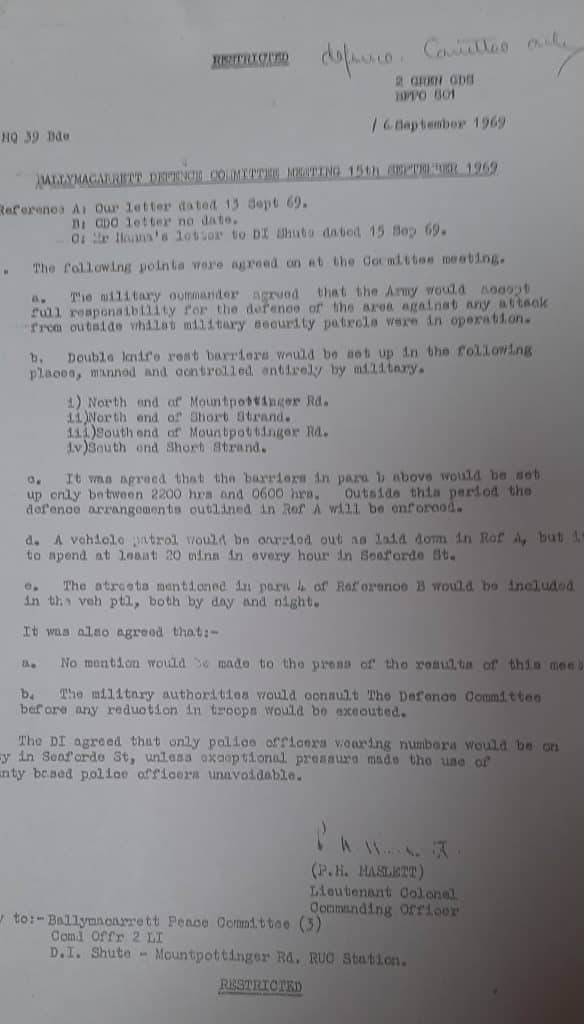
The final agreement between the British Army and Ballymacarrett Citizens’ Defence Committee (CDC)
“ RESTRICTED
2 GREN GDS
BFP 801
HQ 39 Bde 16 September 1969
BALLYMACARRETT DEFENCE COMMITTEE MEETING 15th SEPTEMBER 1969
Reference A: Our letter dated 13 Sept 69
B: CDC letter no date
C: Mr Hanna’s letter to DI Shute dated 15 Sep 69
- The following points were agreed on at the Committee meeting.
a.The military commander agreed that the Army would accept full responsibility for the defence of the area against any attack from outside while military security patrols were in operation.
b. Double knife rest barricades would be set up in the following places, manned and controlled entirely by military:
i) North end of Mountpottinger Rd.
ii) North end of Short Strand.
iii) South end of Mountpottinger Rd.
iv) South end of Short Strand.
c. It was agreed that the barriers in para b above would be set up only between 2200 and 0600 hrs. Outside this period the defence arrangements outlined in Ref A will be enforced.
d. A vehicle patrol would be carried out as laid down in Ref A, but it is to spend at least 20 mins in every hour in Seaforde St.
e. The streets mentioned in para 4 of Reference B would be included in veh ptl, both by day and night.
2. It was also agreed that:
a. No mention would be made to the press of the results of this meeting.
b. The military authorities would consult the Defence Committee before any reduction in troops would be executed.
3. The DI agreed that only police officers wearing numbers would be on duty in Seaforde St, unless exceptional pressure made the use of county based police officers unavoidable.
(P.H. HASLETT)
Lieutenant Colonel
Commanding Officer
Copy to: Ballymacarrett Peace Committee (3)
Cmd Offr 2 LI
D.I. Shute – Mountpottinger Rd RUC Station
RESTRICTED”
Although not specifically mentioned in Colonel Haslett’s letter, two additional issues raised by the CDC in their letter to him were obviously discussed and agreed at the meeting – a circular distributed to local residents confirmed the contents of his two letters, and also stated:
“TO THE PEOPLE OF BALLYCARRETT
Meetings have taken place between the Security Authorities and the Citizens’ Defence Committee for your area. The Military Authorities were represented by:
Colonel P.H. Haslett; Colonel Sibbald; Captain Smith
as Officers Commanding our area. The Defence Committee was represented by:
Mr. Hugh Kennedy; Mr Thomas O’Donnell; Mr Dick Glenholmes; Mr James George; Mr Frank Kane; Miss Phyllis O’Neill and Mr Vincent Hanna, LL.B., as Legal Adviser …
3. Approximately forty-five Soldiers will be involved in any one night, in guarding the area, with large military reserves available at not more than ten minutes notice.
…
6. Application of Special Powers Act guaranteed in writing by Minister for Home Affairs not to apply to persons engaged in the Defence of Ballymacarrett, plus undertaking by Police that no criminal investigations are contemplated, except two specific cases informed to the Committee.”
These meetings, and the correspondence they produced, resulted in what the residents of St Matthew’s parish thought constituted a written agreement by the Army to provide them with protection. Events just over nine months later would prove their expectations to have been misplaced.
The Battle for St Matthew’s 27th – 28th June 1970
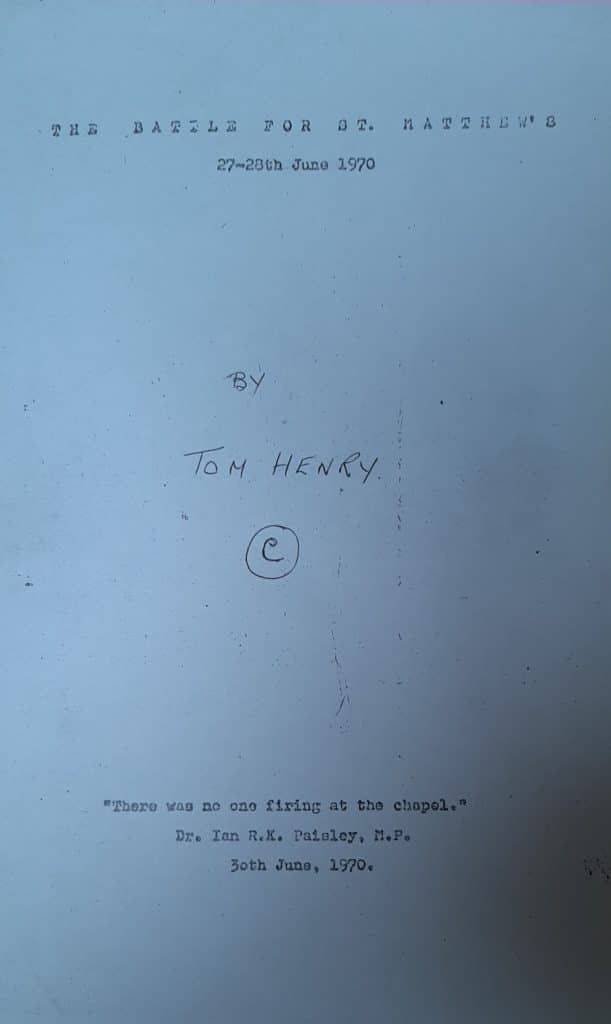
The cover page of Tom Henry’s unpublished manuscript.
What follows is the text of Tom Henry’s pamphlet.
Chapter 1
“Ulster – The Facts” is a booklet published by the Ulster Unionist party from Glengall Street, Belfast. When this pamphlet first appeared in September 1969, Mr Justice Scarman said of it then, “It is unfortunate in its timing and in its authorship.”
Under the heading “Timetable of a Terror Campaign” the July 1970 issue of “Ulster – The Facts” had the following paragraphs relating to events in East Belfast:
“Saturday June 27
On Newtownards Road there is sporadic gunfire from midnight until daybreak in the area’s blackest night since the wartime air raids.
The ‘Belfast Telegraph’ reports later: ‘The heaviest shooting came from St Matthew’s R.C. Church and also in the Seaforde Street area.’ The ‘Sunday News‘ reports: ‘Two snipers with heavy calibre rifles were firing from the belfry of St Matthew’s Church.’
Sunday June 28
The ‘Belfast Telegraph’ later refers to reports of a sniper in the tower of St Matthew’s Roman Catholic Church, Newtownards Road.”
On Friday 3rd July 1970, the Rev. Dr Paisley rose to make his maiden speech at Westminster. He referred to incidents in East Belfast and these are his words direct from Hansard:
“Let me say today that in East Belfast there was a very serious riot, as everyone is now aware. This happened because a tricolour was brought out of Seaforde Street and used to provoke the Protestants on the other side of the road, which happens to be the Protestant side of the road. When the people on the other side moved this tricolour, gunfire came from Seaforde Street, and many of the people were shot. At the same time two policemen were fired on further up the road as they attempted to control the crowd of people coming down to join in the fray, and almost at the same time, from the Roman Catholic chapel on that road there came a burst of gunfire and it was as a result of this gunfire that almost 30 people were injured, and as a result of this gunfire a very serious situation arose on that road.
People came to my home as a deputation and they said ‘What can we do? The army are not there. The police have had to withdraw.’ Because the police are a civilian force now there, they must withdraw when there is gunfire. I got in touch with the Prime Minister’s secretary, and after listening to me he told me to get in touch with the British Army Authorities, and after I got in touch with them they said they were sorry but the lines of communication are so far stretched they were not able to give protection to those people who were under gunfire at that particular time. The facts of this are already available to the Home Secretary if he will make himself available to the Government of Northern Ireland – these facts as I put them here today.”
(Parliamentary Debates, Westminster, Vol. 803 No. 5)
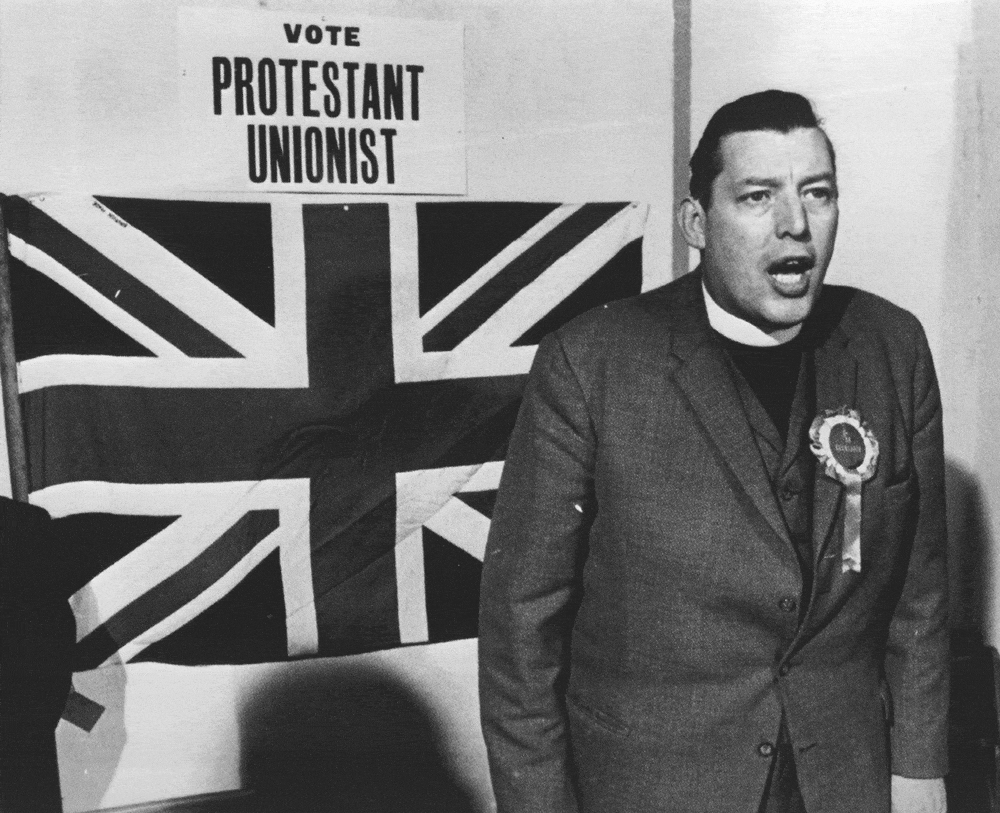
Rev. Ian Paisley
The Rev. Dr Paisley is the “man of God” of whom it was said in the same debate by Mr Robin Chichester-Clark:
“I will make one recommendation to those in the House who are interested in the psychology of resentment. I recommend them to start to read the language used by the Protestant Telegraph which is the mouthpiece of the Hon. Gentleman who now represents Antrim North. Not only is it full of the lowest and most vulgar ridicule of the religion of one-third of his fellow Ulster citizens, but it mocks and derides practically every person or institution committed to peace and stability in Northern Ireland, including the heads of the security forces, who are tackling their unrewarding task with great courage.”
(Parliamentary Debates, Westminster, Vol. 803 No. 5)
For Dr Paisley to say that the riot happened because of a tricolour is not only misleading but dishonest. Dr Paisley told the House of Commons at Stormont on the 30th June 1970: “There was no-one firing at the chapel.” ((Parliamentary Debates, N.I., Vol. 76 No. 27)
This was typical of many of the statements made about the events at St Matthew’s on the night of 27th / 28th June 1970. The trouble for St Matthew’s chapel began long before June 1970 but let us go back to the beginning.
Chapter 2
This chapter is a short history of the building of St Matthew’s in the nineteenth century and the early history of the parish. It is omitted here for brevity.
Chapter 3
It was Hilaire Belloc who said that “no man can understand the present thoroughly without a knowledge of the past.” It is for this reason, in order to understand the events of June 1970, that we should look briefly at the pogrom of 1920.
In the summer of 1920 in Belfast, the principal Unionist press began to publish letters of incitement against the Catholic minority. These letters became more and more violent and suggested that members of the minority had no right to employment, that they were keeping work from “Loyalists”, and that action would have to be taken. Soon, these incitements were taken up more generally by Orange speakers, and on 21st July 1920, Catholic workers were set upon in the shipyards. This was the beginning of pogroms of a horrible nature in which more than 400 people were killed and over 2,000 injured or wounded by armed mobs who operated without any but the most ineffectual interference by the British Authorities. Thousands were driven from their homes and hundreds of these houses were then set on fire by the mobs.
10th July 1921 was a particularly black day in Belfast when Orange mobs burned a total of 123 houses according to a Dublin Castle report. All these without exception were the homes of Catholics. Fifteen people were killed and sixty eight seriously injured. Referring to the burnings the News Letter of 11th July reported “Fires broke out in a number of dwelling-houses and much damage was done by the flames.”
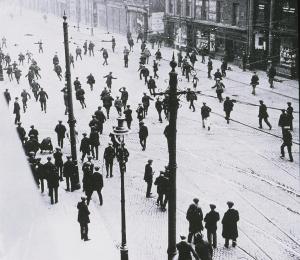
Rioting in York Street, Belfast in September 1920.
St Matthew’s was then a parish living day and night under a state of almost unbroken siege.
On 22nd July 1920, the church was attacked as were the troops who arrived to disperse the mob. Several of the attackers were shot dead by the military. On the 24th July, the convent in Bryson Street was attacked by a mob and set on fire. Again, troops had to disperse the crowds.
On 24th September 1921, a young man of twenty three, Murtagh McAstocker, was recognised coming out of the church and was shot dead. A cross embedded in the concrete forecourt where he fell commemorates this tragedy.
In the next year 1922, on the 23rd April, people were going into the church for the Sunday evening devotions when a bomb was hurled towards the front door from Bryson Street. Some people were injured and one woman, Mrs McCabe, died as a result of her injuries. This was no less than the sixth bomb to be thrown into the church grounds from the beginning of the outrages in July 1920.
One of the last to die in those tragic days of the twenties was in St Matthew’s parish when a seventy year old man, William Millar, on the 22nd June 1922, was murdered in his own home in the Woodstock Road area by an armed gang who rushed into his house and riddled him with bullets.
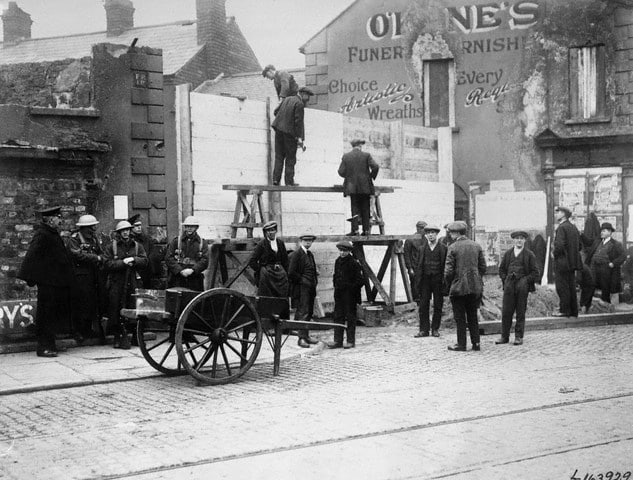
Peace line being erected at junction of Seaforde Street and Newtownards Road, March 1922.
Chapter 4
It is difficult not to come to the conclusion that the very existence of a Catholic place of worship is an affront to the Orange section of the community in that part of East Belfast. It is probable that there were not more than a hundred people in the whole of East Belfast who hate the Catholic Church, but there are thousands who hate what they believe to be the Catholic Church and that is a very different thing. When the new church of St Anthony’s was being built in 1936 at Willowfield, there were demonstrations of bigotry and blatant anti-Catholicism which even for Northern Ireland, the land of “civil and religious liberty” have surely not been surpassed. Here are some of the press reports of the time.
8th APRIL 1936
“A Move to prevent Catholics in Belfast exercising their Religion has just come to light. The decision to build a Catholic church in Willowfield, East Belfast, has provoked the bigots to fury, and efforts are now being made to prevent the church being built.
Plastered on the walls of the east district are posters which read as follows:
ULSTER PROTESTANT LEAGUE
A meeting under the auspices of the above League will be held in
WILLOWFIELD UNIONIST HALL
East Belfast,
ON FRIDAY 17th APRIL 1936,
At 8 p.m.
To protest against the rection of a Popish chapel in this district, thus increasing the anti-British elements in East Belfast.
PROTESTANTS:
Assemble in Force against this incursion of Romanism, which is the same as Sedition in your midst.
KEEP ULSTER PROTESTANT!
GOD SAVE THE KING!”
18th APRIL 1936
“’BLOW IT UP’
Mr Cromlin said that the Government was giving £70,000 a year to the Christian Brothers and the convents of Northern Ireland. The Attorney-General at a meeting in Glengall Street had said that the reason why Catholics were getting jobs in Stormont was that in the examinations they surpassed the Protestants.
If they surpassed the Protestants in examinations, said the speaker, it was because of the education for which the Government was paying, and he (the speaker) thought that the money would be better spent on the unemployed. (Cheers.)
If this chapel went up, he would bring up the artillery (cheers drowned the remainder of this sentence). He would fight the erection of this chapel by every means, legal or illegal. (Loud cheers.)
A Union Jack was produced, and the speaker said this was the only flag he would respect.
The meeting ended with the singing of ‘God Save the King.’
A man then mounted the chair and, waving his cap, shouted ‘There will be no chapel.’”
29th MAY 1936
“DISGUSTING ACTION OF BIGOTS
IN VICINITY OF NEW CHURCH SITE
ANOTHER INCIDENT At WILLOWFIELD
The thousands of respectable citizens of all denominations who have occasion to travel to business from the Cregagh district of Belfast were deeply shocked yesterday by the action of some rowdies in the Willowfield locality, where a new Catholic church is being erected.
In the early hours of the morning while it was still dark, these evil-minded persons came out to the main thoroughfare carrying pig’s head and a large square of cardboard. One of the number proceeded to climb a high tree in the neighbourhood and tied the pig’s head on the trunk afterwards affixing the cardboard beneath it.
When dawn broke it was seen that the cardboard bore the obnoxious words painted in bold letters ‘Cured in Lourdes.’
Passengers in tramcars were loud in their expressions of indignation at this disrespectful insult to Catholics.”
10th JULY 1936
“AMAZING SCENES IN BELFAST
3,000 PEOPLE AT UNVEILING OF ARCH IN WILLOWFIELD
GATHERING OPPOSITE SITE OF NEW CHURCH
Amazing scenes marked an Orange Ceremony in the vicinity of the Catholic church of St Anthony at Willowfield, Belfast, last night, when over three thousand people gathered for the unveiling of an arch by Mr J.W. Nixon, M.P.
For about an hour and a half the tramway and other vehicular traffic of this important artery of the East End was compelled to remain stationary while orators gave vent to their views on ‘Romanism’ and allusions to the new church which is under construction.”
This sort of behaviour follows inevitably from some of the anti-Catholic myths which are spread through the influences of the Orange Order. A typical example is a little pamphlet circulated by the Orange Order called simply “Why Orangeism?”
It is mild compared with “Twenty Reasons for Being an Orangeman” by the late Rev. Dr Drew. The following will illustrate:
“9. Because I learn by the doctrines, history, and daily practices of the Church of Rome, that the lives of Protestants are endangered…
12. Because the Church of Rome teaches in her schools that heresy is not to be endured, nor heretics to be permitted to live!
14. Because notwithstanding the private worth of many members of the Roman Church, that, generally, Roman Catholic jurymen refuse to give a true verdict according to the evidence, when the cause of their Church or party is presumed to be at stake.”
Chapter 5
One of the hallmarks of democratic society is equality of opportunity. Where there is not equality of opportunity then there is discrimination. In 1966, His Lordship, Most Rev. Dr Philbin, Bishop of Down and Connor, made public a correspondence between himself and the Managing Director of the Sirocco Works, Bridge End. It is important to bear in mind that the Sirocco Works is a public company (Davidsons) whose shares are quoted on the Belfast Stock Exchange. It has also been the recipient of government grants from public funds.
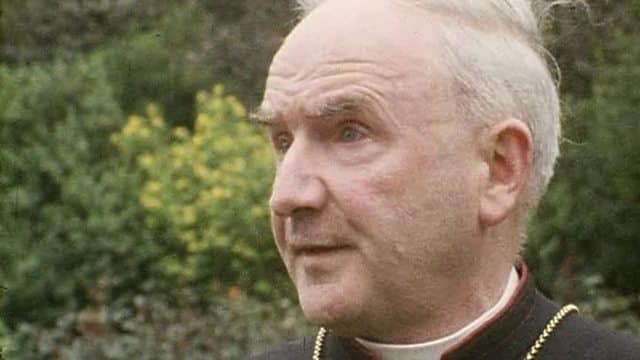
The Most Rev. Dr William Philbin, Bishop of Down and Connor.
In his first letter to Mr McGuire, on 9th May, Dr Philbin said:
“I write to you about a matter which I have thought a good deal about for a considerable time and which I feel, as I hope you will agree, ought to be cleared up,
The area in which your factory is situated forms part of the Catholic Diocese of Down and Connor and the duty of visitation of parishes in its vicinity falls therefore on me. Since my coming here four years ago I have several times, and by many different people who live in the districts I refer to, been told that the Sirocco Engineering Works, out of a work-roll of approximately 1,500 people, employ scarcely any Catholics. It has been said that only one Catholic is employed there, and lately I have heard the figure of three or four.
These estimates of the total employment-roll and of the number of Catholics employed may both be grossly incorrect and if this is the case I feel sure you will be happy to place me in a position in which I could assure those who spoke to me about the matter that what they have said is quite untrue. I am aware that firms do not keep an account of the religious denomination of their employees but I have also become aware since coming to Belfast that whether one is or is not a Catholic is regularly a matter of general knowledge. I believe, therefore, that your officials who have to do with personnel would have no difficulty in ascertaining how many Catholics are actually in your employment.
Will you kindly let me know what the figure is, and also what is the total number of your employees. This request is, of course, unusual but I can only make the obvious point that conditions in our city are also unusual in respect of the issues on which I write. In these days efforts are being made in many quarters to eliminate causes of tension and, as a widespread belief among Catholics to the effect I mention can only be a factor in maintaining conditions deplored by all responsible people, I am asking you, as head of a large and influential industrial organisation, to assist me in an important matter of public interest.”
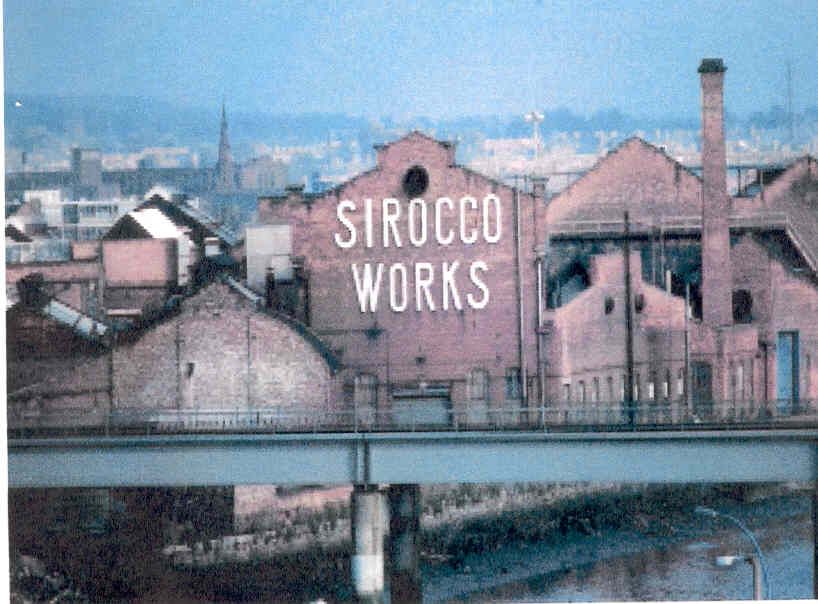
Acknowledging this letter on 11th May, the Sirocco Chairman said:
“The fact that there are but few Catholics employed in the Works is not a matter of Management policy but arises largely due to the location and environment.
We have had in the not-too-distant past a Roman Catholic Director. In very recent months the applicants for a senior executive position were whittled down to two candidates, one of the Church of Ireland and the other a Roman Catholic. That the former was ultimately selected had nothing to do with religion, merely his better technical qualifications.
Amongst our staff I have no idea of the exact number of Catholics employed as I do not make a point of enquiring into their religious beliefs.
In the shops there are indeed very few Catholics. Since the earliest days of the company the Protestant element from the Memel Street and Newtownards Road areas have provided the bulk of our workmen, and large numbers are now in the third or fourth generation of original families. Catholics probably do not feel at home in a Protestant atmosphere.
This preponderance of Protestant employees will presumably change when a large number of Catholics come to live in these areas, and when religious tolerance comes to be more widely accepted by the working public at large.
The crux of the matter is therefore an external one and not an internal one.”
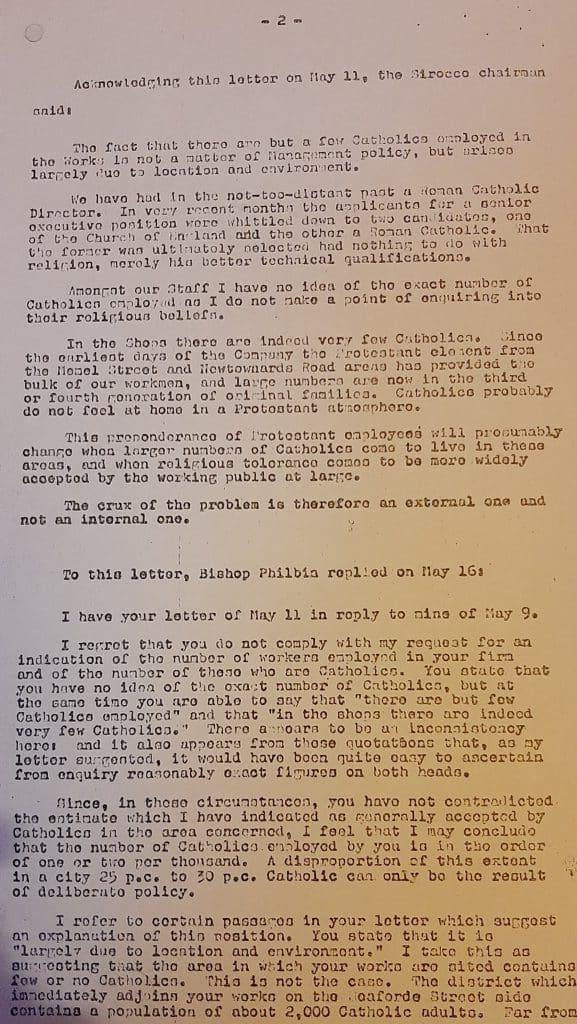
Bishop Philbin accused the Sirocco Works of practicing religious discrimination in employment
To this letter, Bishop Philbin replied on 16th May:
“I have your letter of 11th May in reply to mine of 9th May.
I regret that you do not comply with my request for an indication of the number of workers employed in your firm and of the number of those who are Catholics. You state that you have no idea of the exact number of Catholics but at the same time you are able to say ‘there are but few Catholics employed’ and that ‘In the shops there are indeed very few Catholics.’ There seems to be an inconsistency here and it also appears from these quotations that, as my letter suggested, it would have been quite easy to ascertain from enquiry reasonably exact figures on both heads.
Since, in these circumstances, you have not contradicted the estimate which I have indicated as generally accepted by the Catholics in the area concerned, I feel that I may conclude that the number of Catholics employed by you is in the order of one or two per thousand. A disproportion of this extent in a city 25 p.c. to 30 p.c. Catholic can only be the result of deliberate policy.
I refer to certain passage in your letter which suggest an explanation of this position. You state that it is ‘largely due to the location and environment.’ I take this as suggesting that the area in which your works are sited contains few or no Catholics. This is not the case. The district which immediately adjoins your works on the Seaforde Street side contains a population of about 2,000 Catholic adults. Far from there being any prospect that ‘large numbers of Catholics (will) come to live in these areas’ the fact is that Catholics have been removed from this district to the extent of 500 people in recent years and there is at present a threat of the mass removal of most of those that remain – a situation which in fact has caused numbers of them to come to me and call my attention to this prospect as well as their general position in relation to your firm. They find it difficult to see either of these factors in isolation.
I cannot understand how an industry of your size and importance can write in a manner suggesting unawareness of the projects for removing large sections of the population from an area immediately adjacent to you and refer, instead, to a probably influx of new residents. Every informed person in the area knows what is being planned and what its effects will be on the Catholic population. In such an event your employment policy will, of course, be obviously less open to criticism.
Perhaps on reflection you would not care to maintain the suggestion that the situation in regard to employment can be explained by saying ‘Catholics probably do not feel at home in a Protestant atmosphere.’ I make no comment on the frank assertion that the atmosphere of your firm is sectarian. But do you seriously suggest that the non-employment of Catholics in your firm is due to a reluctance on their part to be employed by you? Can anyone believe that Catholics in this city have ever been able to afford the luxury of choosing employment only where the atmosphere is congenial to them? You know that in conditions of permanent under-employment of labour such as have obtained here it is the employer, not the employee, who is in position to choose. You must be aware that in Belfast Catholics have always worked wherever they could find work. Discrimination could only have been exercised by employer against employee; your letter is the first suggestion I have ever encountered that the reverse has been the factor operative here.
I suggest that responsibility in this instance attaches clearly to your firm. Indeed your own words to the effect that ‘the bulk of (your) workmen’ consists of third and fourth generation workers of ‘the Protestant element’ from the Memel Street and Newtownards Road areas bears out the impression conveyed to me by so many people, your firm has been regarded by generations of Catholics in your area as a symbol and concrete evidence of the economic and social injustice they have had to suffer for many generations in this city. There is a tradition here of ‘No Catholics need apply’; this must be as well known to members and workers of your firm as it is to Catholics living beside your works who realise from experience that neither they nor their forbears can or could ever hope for work from you.
I regret to find that your letter conveys that you feel no responsibility in this respect even in the more enlightened atmosphere which many people hope exists today. The general sense of your letter is indicated in such phrases as ‘the crux of the problem is an external one not an internal one’, ‘This preponderance of Protestant employees will presumably change when larger numbers of Catholics come…and when religious tolerance comes to be more widely accepted by the working population at large.’
I find the implication that you can and should do nothing to correct the extreme forms of religious discrimination for which your company is responsible, a matter of grave concern. You are, I understand, one of the largest employers of labour in Belfast. I feel bound in these circumstances to take this matter further and I presume you have no objection to my making use of your reply, or replies, in conjunction with my own letters.”
Mr McGuire acknowledged this letter on 19th May as follows:
“I acknowledge receipt of your letter of the 16th instant, and if you wish to further this matter, I suggest that you should arrange to see me in my office by appointment.
I would take it as an act of extreme discourtesy if you were to make use of what was a personal interchange of letters between us prior to any such meeting and discussion.”
To this letter the Bishop rejoined on 25th May:
“I have your letter of 16th May, 1966.
I cannot accept your suggestion that I should arrange to see you by appointment in your office. I believe that matters such as this are best treated in writing. As to our letters, I do not agree that they are personal. On the contrary, I wrote to you as Chairman of the Sirocco Engineering Works in my official capacity as Bishop of Down and Connor.
The position now tis that there emerges from our correspondence, it seems to me, clear evidence that there is virtual non-employment of Catholics in your works. You say your firm is not to blame; that the factors are external and their removal must await a change in attitude on the part of the public.
Having considered this whole situation with all care I have come to the conclusion that I have no alternative but to make the public aware of these facts. They should be allowed to judge whether and how far they, and not you, are indeed responsible. I therefore propose to release our correspondence to the press.”
Reference is made by His Lordship to “planning” which is feared may result in the scattering of St Matthew’s parish as it is now known. When the Belfast Corporation’s £77 million ring road development plan was issued in 1966 it showed that the road would not touch the parish and the St Matthew’s Tenants’ Association pointed out three sites which could be used to rehouse parishioners before their homes were pulled down. In a new plan, a year later, the road would have passed through the three sites indicated.
Mountpottinger Road – Vulcan Street – Newtownards Road – Bryson Street – Beechfield Street – Seaforde Street has been designated a redevelopment area (1973) as has Mountpottinger Road – Albertbridge Road – Short Strand – Anderson Street (1974).
Already 500 people have been uprooted and rehoused at Turf Lodge estate from the Foundry Street area of the parish. The secretary of St Matthews’s Tenants’ Association in the course of a long letter to both the Ministry of Development and Belfast Corporation wrote as follows in 1966:
“We are an old established community in East Belfast – long before 1830 when we built our first church. Since then in 1884 we have built a good solid church – as good as the best in Belfast. In succeeding years to these we have added a Presbytery, a Convent, 2 Primary Schools – one for boys one for girls (recently renovated at a cost of £30,000 and in excellent condition). We have helped to erect the Intermediate School St Augustine’s for 11 plus boys and St Mocvincas’s for 11 plus girls, and in all we have paid our way in full. Our pupils have easy access to the Rupert Stanley Technical School and avail of it.
We are an old established community, still retaining the homeliness of the village atmosphere and we know that we are within our rights in insisting on our own preservation. The Housing Act of 1957 says ‘people should as far as possible be rehoused in their locality.’ It has been proved lately that the useless uprooting of communities is an additional cause of juvenile delinquency.”
Chapter 6
When the rioting began in Derry on 12th August 1969 on the occasion of the Apprentice Boys’ Parade it subsequently spread to Belfast on the following days. The Army finally was called into the Falls and Ardoyne areas to save further loss of life and destruction of property. East Belfast, contrary to reports, did not escape unscathed.
During the months of August and September, in that area of the city covered by the postal districts 4, 5 and 6 no less than 32 licensed premises were attacked or threatened as follows:
Completely destroyed 5
Partially destroyed or looted 24
Threatened 3
32
On Friday 5th September 1969 requests were made to the Army authorities, R.U.C. and the Ministry of Home Affairs for protection for public houses, particularly in East Belfast.
That weekend a total of five licensed premises in the East End of Belfast suffered severe damage:
- Mr F. Brennan “Great Eastern Bar” 273 Newtownards Road
- Mr. O. McMahon 118-120 Newtownards Road
- Miss M. Lynch 112 Newtownards Road
- Mr. P. Woods 104 Newtownards Road
- Mr. J. Gallagher “Ulster Vaults” Bridge End
The eye-witness accounts of that weekend relating to premises on the Newtownards Road follow, together with an incident relating to the Armagh House at a later date.
“I was a member of the Citizens’ Defence Committee of the Seaforde Street and Ballymacarrett area. This committee was deputed to attempt to protect Catholic houses from intimidation and attack. On Sunday 7th September at 2.30 a.m. I was standing at the corner of Seaforde Street and Newtownards Road in the company of ….. There was a Sergeant and two policemen at the corner of this street and we had been in their company for about four hours guarding the area. We heard glass breaking and the sound of bottles. This was coming from Lynch’s public house, 112 Newtownards Road which was about 60 yards away on our right and on the opposite side of the street of the Newtownards Road. It is at the corner of Gertrude Street and there was a barricade at the mouth of this street. I saw a crowd of about twenty or so behind this barricade. They were breaking the windows and entering the premises. I asked the Sergeant to go over and he said that he not allowed to move. There was a light on upstairs and I thought there was an old lady living at the premises. I told the Sergeant this but he said he could not move.
The rioting and looting went on for about an hour and about twenty policemen arrived and stood at the road opposite the premises. After ten minutes, five soldiers arrived, they went over to the premises. They were attacked by bottles and the police then moved over. I saw four people being taken away. The soldiers and police then left. The crowd continued to move in and out of the premises and this continued until I left at about 7 o’clock. They were staggering about the Newtownards Road drunk and there seemed to be a sing-song in a house six or seven doors down on the right side of Wolff Street. A man named ….. of ….. Street come over to me, ….., the Sergeant and two policemen and offered to give us a half bottle of wine for a packet of cigarettes.
During the night I also heard banging at Woods’ public house, 104 Newtownards Road but could not see as the damage was down the side street.”
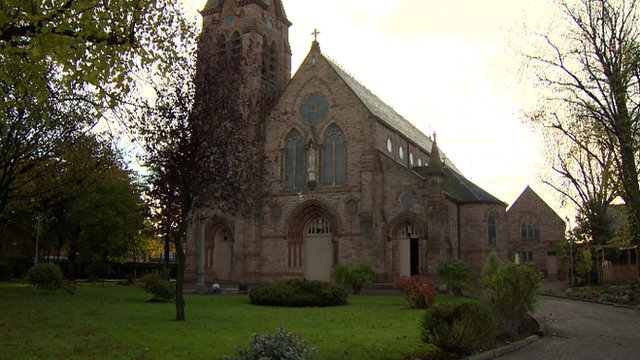
“On Sunday 7th September 1969 I was on guard at St Matthew’s Roman Catholic church on the Newtownards Road at 2.30 a.m. A crowd began to attack Lynch’s public house on the Newtownards Road opposite to where I was.
There was a light on in the premises and I thought there was an old woman living there. I went down to speak to a friend, ….., at Seaforde Street corner and then went back and spoke to two policemen at the corner of Bryson Street and asked them to go over to the premises but they refused. The damage and looting of Lynch’s public house continued for about one hour and then about twenty policemen arrived and stood at the railing of the church. About 10 minutes later five soldiers arrived and they went over to the premises and the police followed and then I saw four people being taken away and then they all left.
There was not a large mob, I do not think there was any more than twenty people and they were still there when the police left. Immediately the police left I saw a few of them go back into the bar, and they continued to go in and out of the public house until I left at 7.30 a.m.
After the police left I went across the Newtownards Road along the railway and I saw about 15 people collecting a store of cases of beers and cartons of cigarettes at the railway arch to Fraser Street. I went back and reported this to my committee who reported this to Mountpottinger R.U.C. station
On Wednesday 10th September 1969 I was standing at a gateway at Austin Street and I saw five men with red arm bands attempting to burn McMahon’s public house on the Newtownards Road. They had a gallon can of petrol, filling bottles and making petrol bombs. They threw a number of these through the windows. A crowd of people came from Josephine Street and put the fire out and the five men went away. There were two policemen at Bryson Street corner and three at Seaforde Street corner.”
“On the morning of 26th September 1969 at 3.30 a.m. I was in the Short Strand in the corner of Thompson Street in the company of ….. of ….. I saw a Belfast Co-operative Society lorry come down Ravenhill Road and stop at the lights. This lorry had the letters U.C.B.S. on the front of it and was a large ten to twenty ton bread lorry normally used for provincial deliveries.
I saw three men come out of Georges Street entry, which runs behind Armagh House, which is a public house on the opposite corner from where the lorry was stopped. The men went to the cab of the lorry and ran back into the entry. Close behind them was another group which did likewise. In all there were about nine to twelve men. There was a policeman standing outside Armagh House and there was another policeman standing at the Bridge Bar which is at the corner of Short Strand and Madrid Street, opposite Armagh House. There were five to six soldiers in the Short Strand opposite Thompson Street. I went back into Short Strand about ten minutes after. Armagh House was on fire. The Fire Brigade were there and about thirty policemen and about thirty people watching.”
Even after September 1969 incidents were taking place in East Belfast – intimidation, assault, even shooting in the streets and the throwing of petrol bombs. Because of the high level of industry in East Belfast, taking in places like the shipyards, the aircraft factory, Sirocco Works, the ropeworks, incidents tended to be played down and as far as the rest of Belfast was concerned, Ballymacarrett was peaceful. Residents of St Matthew’s knew differently and indeed some of them were of the opinion that there was a deliberate “conspiracy of silence” as to the true nature of events.
It is well known that Linfield football club draws a lot of its support from the Orange districts of Sandy Row and Shankill Road. On Saturday 11th January 1970, Linfield played Glentoran at The Oval which is in East Belfast near the Newtownards Road. It is interesting to compare the court reports, as they appeared in two Belfast papers, arising out of incidents at and after the match on that day.
“A mini riot developed on Saturday afternoon when Linfield and Glentoran met at Belfast’s Oval football grounds, a court was told today.
D.I. Harry Shute said this at Belfast Magistrates’ Court when a number of people appeared on charges arising out of the trouble.
D.I. Shute said the fracas started at half-time when stones and bottles were thrown by opposing factions.
Had it not been for prompt action by the police a serious situation would have arisen.
He said the mini-riot continued on Newtownards Road and there were provocative actions and words towards other people.
At the Newtownards Road chapel and at Seaforde Street songs were chanted and the National Anthem sung.”
(Belfast Telegraph, Wednesday 14th January 1970)
“Incidents at and near the Oval football ground, and on the Newtownards Road afterwards, on the occasion of the Glentoran – Linfield Irish League match last Saturday, led to the conviction of nine men on disorderly behaviour charges at Belfast Magistrates’ court yesterday.
Two were fined £10, six were fined £5 and one was fined £2. The case against another man was dismissed, while the case against a tenth man was withdrawn.
A charge of disorderly behaviour at Seaforde Street, Newtownards Road against a 20-year-old serviceman was dismissed.
Four pleaded guilty to disorderly behaviour in the Oval; one to the same charge in Dee Street, one at Templemore Avenue, and two at Seaforde Street and one at the Newtownards Road.”
(News Letter, Thurs. 15th January 1970)
If one should think that the scenes at the January match and afterwards were not typical of the Orange mob then the following extract from the Monday News Letter after the Glentoran v Linfield match in August 1970 should convince:
“Trouble in the Newtownards Road erupted when a crowd of nearly 2,000 waving Union Jacks and Linfield scarves formed up in Dee Street and marched down the main road.
Rubble was hurled as the crowd passed Seaforde Street, which had been sealed off by troops, but police formed a three deep cordon and shunted the mob towards Bridge End. Some shop windows were smashed.”
(24th August 1970)
Chapter 7
At the General Assembly of the Presbyterian Church in Ireland the Rev. Martin Smyth warned that if any enforced attempt were made to ban the Twelfth of July parades, disorders could spread through the province. The Belfast Telegraph of 3rd June 1970 reported:
“The warning came from the Rev. Martin Smyth, Grand Master of the Grand County Orange Lodge of Belfast, during a clash over the question of whether the Assembly should recommend that the Twelfth parades should be called off.
Mr Smyth said ‘I would like to clarify any misunderstanding throughout our land in view of the situation we find ourselves in in Ulster at this time. Anyone who believes that an enforced or voluntary ban on the Twelfth will bring peace is either a knave or a fool.
Let it be said quite frankly that last evening a lodge was diverted and a feeling in the hearts of the people in that area, who had suffered over a number of months, was brought to a head.”
It is important to remember that the parades, marches and processions held by the Orange Order in any year are numbered in hundreds. In 1968 the number was no less than 933! This includes church parades, local parades for the unfurling of banners as well as the Twelfth of July parades. It can be readily understood that in the weeks preceding the Twelfth, tension builds up in a tiny Catholic area like St Matthew’s where the “Mini-Twelfth” parade to be held in East Belfast on 1st July plays such a part in the Orange calendar. Rumours were rife that an attack on the Catholic community would come either at the weekend of 27th / 28th June or on Wednesday 1st July – the day of the parade itself.
Accordingly, two representatives of the St Matthew’s Citizens’ Defence Committee (C.D.C.) on the 12th June obtained a meeting with Major Welldon representing the British Army and pointed out the dangers of the situation, indicating to him the streets and buildings which they considered exposed to attack. They were assured that it was the Major’s particular responsibility to protect the minority. Months earlier, the C.D.C. had had meetings with the Army and amongst agreements arrived at were the following:
- The Army would accept full responsibility for the defence of the area against any attack from outside.
- There would be no reduction in troops without prior notice to the C.D.C.
- Approximately forty-five soldiers would be involved in any one night in guarding the area, with large military reserves available at not more than ten minutes notice.
On Saturday 27th June processions were held in various parts of Belfast although there was no parade as such due to take place in the Newtownards Road area. However, it was known that the Gertrude Street Band would be returning from another area that evening.
One eye-witness described the scene as he saw it:
“At approximately 6 p.m. the Gertrude Street Band approached the Newtownards Road – Seaforde Street area accompanied by a crowd of about 60 – 70. The people accompanying the band were acting in a very boisterous manner, singing party songs and shouting offensive anti-Catholic slogans. The police (I saw three at this time) took no action. When the band and its followers, now numbering well over 100 were directly in line with the entrance to Seaforde Street the procession came almost to a halt. The people in the procession then stepped up their campaign of abusive and very offensive anti-Catholic shouts. There were now some 30 – 40 people in Seaforde Street, many of whom were asking the police to move the procession on. The police now numbering five did not do this but seemed more intent to push the people from Seaforde Street further up the street from the Newtownards Road. A hail of pennies and particles of broken glass were thrown into Seaforde Street and still the police took no action.
About ten minutes after the parade passed Seaforde Street more police came along Seaforde Street to the Newtownards Road corner. At the same time a crowd of about 150 approached along the Newtownards Roads singing party songs and shouting abuse towards Seaforde Street. Once again appeals were made to the police to move this mob, but the police instead lined across the entrance to Seaforde Street. When the mob was almost in line with the entrance to Seaforde Street, there was a barrage of stones, broken glass and pennies which lasted about five minutes. Some of the police during this time were trying to push the Seaforde Street people further up the street while the remainder of the police appeared passive as Seaforde Street was subjected to this hail of missiles and abuse.
It was about this time that the efforts of those trying to persuade the people from the Seaforde Street area to go to their homes began to pay dividends. The people were being advised that the best course was to clear the street by going into their houses and trying to take no notice.”
There was talk in at least one public house that evening of a plan to attack Seaforde Street and at about 8 o’clock a member of the St Matthew’s C.D.C. was summoned to a meeting in Mountpottinger R.U.C. barracks and advised to expect trouble that night. It was apparent that the police had knowledge of something in the offing and the C.D.C. member enquired how many troops were available. Major Watson was then sent for and briefed with particular reference to potential flashpoints. He, Major Watson, informed the meeting that not more than 20 soldiers could be spared to guard the whole area.
The St Matthew’s C.D.C. was primarily concerned that the church complex should be protected in the event of petrol bomb attack and then secondly, to look after the welfare of those parishioners living in isolated areas subject to intimidation. In this connection it is worth pointing out that more than 150 families had to leave their homes due to intimidation and threats between the period from August 1969 to June 1970. The streets could be listed but no useful purpose would be served as invariably threats came, not from Protestant neighbours, but from strangers to the localities.
Tension was rising in the area and the church was locked by the sexton at approximately 8.50 p.m. in accordance with usual practice. The presence of “loyalist” hangers-on on the Newtownards Road had kept a number of the young men of Seaforde Street in attendance and there was the expected exchange of verbal abuse – but nothing more than that.
However, after “closing time” it was not long before a mob began to gather, but let an eye-witness tell his story:
“At approximately 10.45 p.m. another mob began to form on the Newtownards Road. This numbered about 200 and began to move towards Seaforde Street. They were shouting the usual anti-Catholic slogans and some were shouting ‘We’ll burn the fenians out!’ At this time I saw only four or five police who took up position across Seaforde Street while the mob on the Newtownards Road approached Seaforde Street unhindered. The police were taking little action to disperse the mob on the Newtownards Road where I saw possibly three or four police at this time – about 11 p.m. When the mob were directly in line with Seaforde Street the verbal attack was stepped up and at this point another six or seven police arrived on the scene. These extra police, together with those already on duty in Seaforde Street, began to stand across Seaforde Street and it was then that three shots range out. At this time I was at the corner of Seaforde Street and saw a flash in the upper window of an empty shop adjacent to the Fast Taxi office. Along with the rest of the people I took cover. I am convinced that there were too few police on duty, and that the police who were on duty seemed to be preoccupied with the people in Seaforde Street whilst the mob on the Newtownards Road, who were intent on creating trouble, received too little attention from the police.”
This eye-witness was apparently unaware that just prior to the outbreak of shooting a tricolour was raised on a derelict building at the corner of Seaforde Street and the Newtownards Road. Naturally enough, there was a frenzied reaction from the Orange mob and it was at this point that the shots range out. There is considerable confusion as to where these shots came from and doubtless both sides would claim that the other side fired first. At any rate, from this moment the situation rapidly deteriorated and although a formation of police was seen marching up Seaforde Street, they did so only to turn into Vulcan Street, then into Saul Street and into the cul-de-sac of Young’s Row.
Another eye-witness describes what he saw:
“On the 27th June 1970 I left work at 11 p.m. and arrived at Seaforde Street at 11.20 p.m. There were two policemen on duty at the top end of Seaforde Street, and there were 10 to 12 men sitting at the corner of Wolff Street with bottles in their hands and shouting into Seaforde Street. I was concerned at the lack of police and military in the area and proceeded to go to Mountpottinger barracks. On the way I passed twelve to sixteen policemen running down into Seaforde Street.
I then proceeded to go home but as I got near home I heard shooting. I ran back down into Seaforde Street where there was much confusion and panic among the people. I could hear them saying ‘They are shooting, they are shooting.’
I then heard that the church was under attack. I ran round into the church grounds and could see men on the railings throwing petrol bombs at the sexton’s house. I ran back to the school to telephone the Army. I could not contact the Army. I then proceeded out of the school to go round to the church grounds again, when I was stopped and told there was heavy shooting in the church grounds and was advised to stay in the school. I stayed in the school and could hear the shooting going on.”
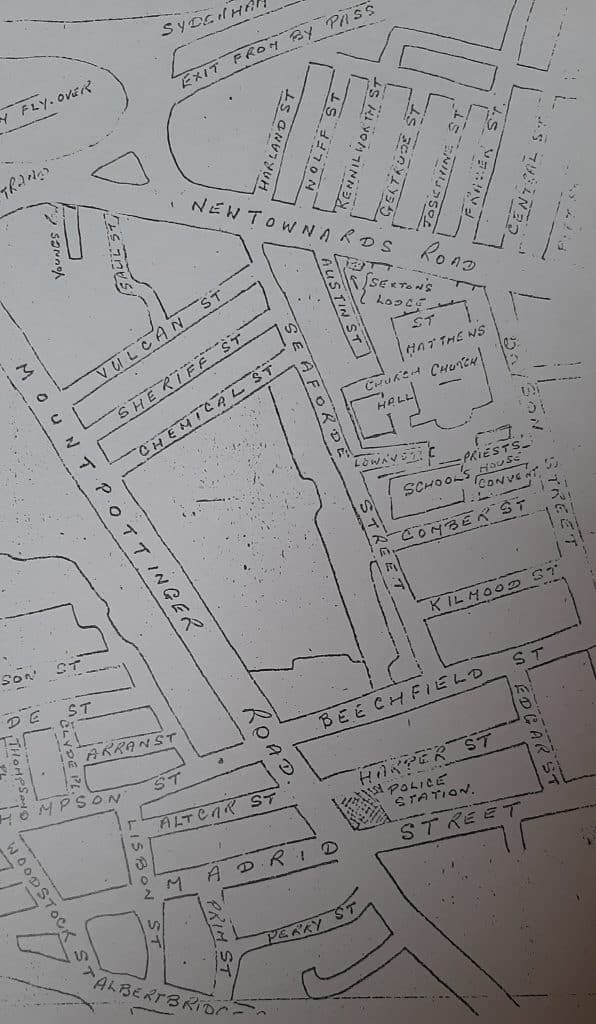
Map hand-drawn by Tom Henry, showing the church and surrounding streets
There were upwards of 300 terrified souls – men, women and children – sheltering in the school and one can only imagine the anguish of those unfortunate people as they listened to the gun battle outside. If one refers to Map No. 2 of the area (not to scale or to be taken as accurate) one can see that only the church building stands between the Newtownards Road and the schools and convent. One must also remember that the mob on the rampage outside the church on the Newtownards Road had already set fire to the sexton’s lodge as well as the two Catholic-owned licensed premises opposite the church – Woods’ at the corner of Kenilworth Street and Lynch’s at the corner of Gertrude Street. Petrol bombs were being hurled at the church and all the gunfire being exchanged was concentrated at the church, which was now covered by a thick pall of dark smoke from the burning buildings in the vicinity.
An eye-witness takes up the story again:
“Mr Paddy Kennedy M.P. arrived on the scene and he and I decided to go to the barracks and ask for military protection. We spoke to the Army Major, D.I. Shute, Head Hammond and Head Moore, and County Inspector Carlisle. The Army said they would send troops into the area. We waited patiently for the Army to come into the area but all they did was bring three armoured trucks into Seaforde Street and they sat there.”
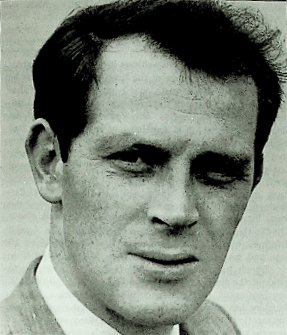
Paddy Kennedy MP, member of the CCDC
Fr Murphy of St Peter’s and Tom Conaty, the Chairman of C.C.D.C. were in constant communication with the military authorities by telephone, requesting and demanding that troops should be sent in. They were informed by Brigadier Hudson that the military had no desire to get caught in cross-fire and also they suspected that the situation might be a trap!
The Army was advised that if troop reinforcements were to arrive and deploy themselves in the church grounds then the armed defenders would at once withdraw entirely from the grounds. Permission was readily given by Fr Hurl for the Army to knock down the gate pillars if necessary. It is believed that the armoured vehicles made one sortie along the Newtownards Road, but on being petrol-bombed by the Orange mob, they withdrew from the scene and spent the rest of the night in Seaforde Street. Sporadic firing continued until well after day-break.
At about 6.30 a.m. on the Sunday morning, Mr Paddy Devlin M.P. who had arrived in the area some 30 minutes or so previously, saw three men in Bryson Street throwing petrol bombs at the priest’s house. He drew the military’s attention to this activity and enquired whether the troops would act on General Freeland’s directive concerning petrol-bombers. He was told that “in circumstances like these, the soldiers were powerless”!
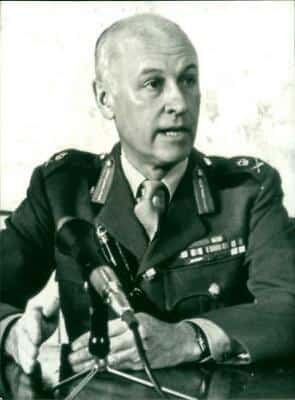
General Sir Ian Freeland, General Officer Commanding British Army in Northern Ireland
It is perhaps significant mention that earlier in the morning when the military were being urged to deploy themselves and their vehicles in front of the church Major Addison was heard to remark to Lieutenant Miles that “these people must be left to the consequences of their own folly.”
It was only after more persuasion by Mr Paddy Kennedy M.P. that the Major gave the order to knock down the pillars to enable the troops and their vehicles to take up position in the church grounds.
The battle in Ballymacarrett for St Matthew’s was over – but at a cost of at least 3 people dead and 30 others wounded.
Chapter 8
Before the dust of battle had settled, reports were circulating throughout East Belfast that fire had been opened up from the belfry of the church tower. This rumour then became “fact” and was circulated by John Brooke’s “rumour service” as such. The News Letter as late as the following Thursday morning was still able to report the claim of East Belfast Young Unionists that snipers had been operating from the belfry. The Dublin magazine This Week in their issue dated 10th July printed the following in an article by Dick Grogan:
“The Protestants’ sole achievement, apart from scorching the doors of the church with petrol bombs and burning down the sexton’s house, was to shoot two of the snipers as they finally clambered down from their lofty firing position on the steeple. One of those Catholics has since died.”
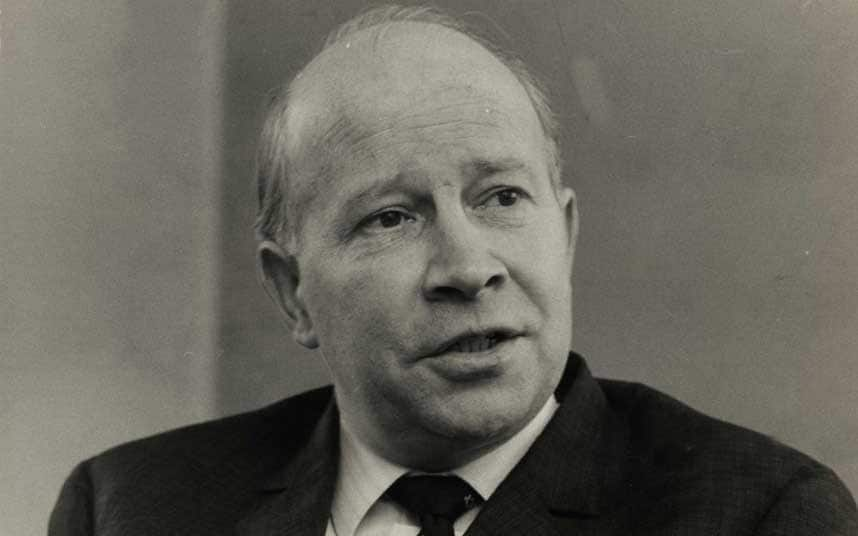
Sir Robert Porter, Stormont Minister of Home Affairs
On Tuesday the 30th June Sir Robert Porter who was then Minister of Home Affairs made the following statement in Stormont:
“While dealing with shooting incidents let me refer to that which occurred in Ballymacarrett and to which reference has been made by several Hon. Members. I think it was the Hon. Member for Central (Mr Patrick Kennedy) in particular who challenged me to say what the military information was regarding the sniper who was alleged to be in the tower of St Matthew’s Roman Catholic church. So far as this incident is concerned I am informed that at approximately 2.30 in the morning the soldiers returned fire against a sniper who appeared to be shooting from the tower. Let me also make it clear that in subsequent investigations it was not possible to establish whether or not any such person had been in either the church or the tower. But there was evidence that a gunman had been shooting from the grounds of the church itself. I hope this will clear the doubt which appears to be in some people’s minds as to what in fact happened on this particular occasion.”
(Hansard, Vol. 76, No. 27, Col. 2026)
On Wednesday 1st July 1970 the Army issued the following official statement:
“There have been rumours that snipers fired from the belfry of the church during the weekend. Reports indicate that this was untrue and that the firing came from the area immediately outside the church.”
The truth about the belfry is as follows: before 7 a.m. on the Sunday morning a British Army officer requested the keys to open up the church and make an examination of the belfry. The keys were at once forthcoming and one of the priests accompanied the officer into the church which was examined before the party proceeded to mount the tower. The belfry is thick with dust; consequently if it had been used by a “marksman” the evidence would have been plain to see – footprints and spent cartridges in the ledges or crevices. The belfry was thoroughly searched and the officer professed himself satisfied that nobody could have been there.
It should be mentioned that access to the belfry even in daylight is hazardous. The slanting boards have the effect of limiting the field of vision considerably and any “marksman” using the apertures would be taking a very high risk with his own life should he be spotted and fire returned. Despite this thorough search in daylight, the rumour persisted and continued to be circulated throughout the day, and at 7 p.m. another officer made a second exploration of the tower and belfry. Again nothing was found and again the officer professed himself satisfied that there could not have been firing from the tower.
On the Tuesday evening a third officer made yet another examination and on the Wednesday evening a fourth search was made which this time included the whole church. Offertory-boxes were unlocked, cupboards opened and the Holy Water barrel plumbed. All that the search produced were three C.S. gas capsules and holes in the windows indicated that these had been fired into the church. The searches received the fullest co-operation from the priests and the troops were encouraged to extend their search to all the buildings of the church complex, the convent included. If any one fact emerged from the searches it was that there had been nobody in the tower that weekend before the officer examined it on Sunday morning.
The first of the inquests was held on 16th September and below appears the report which was published the following day:
“An open verdict was returned at an inquest in Belfast yesterday on Robert Neill (44), of Central Street, who was shot dead in the vicinity of St Matthew’s church, on the Newtownards Road, on the night of 27th June last.
Inspector John Hammond, of the R.U.C., described the scene during the night and said that gunmen were ‘shooting people like flies’ from the grounds of the chapel.
The Inspector said that tension rose in the Newtownards Road area after a band had passed along the road following a parade in the city.
A crowd gathered in the evening and went up and down the Newtownards Road. However police succeeded in getting the crowd away from the Catholic Seaforde Street area.
Continuing, the Inspector said: ‘We got them away when a fellow jumped up on top of a shop and waved a big tricolour. The crowd on the Newtownards Road then surged back towards Seaforde Street.
‘At that time, a man, who has since been identified, came out of Seaforde Street and fired five shots, wounding two men and one woman. The man ran up Seaforde Street, and from then on the situation snowballed.
‘Another fellow started firing and wounded two men. Firing then opened from the chapel grounds.’
The Inspector said that 30 people were injured and that Neill was short dead in the vicinity of the chapel.
The City Coroner, Dr Herbert Lowe, asked the Inspector if he was sure that there was firing from the grounds of the chapel. He replied ‘There is absolutely no doubt about it. There was a sniper between the spire and the chapel roof, and they were firing from the grounds of the chapel. It was murder, no matter where it came from.’
The Inspector added that, when the shooting started, there was no help available for the police who were unarmed and the public remained unprotected.
He radioed for help, but was told that the Army was not available because the troops were committed elsewhere. An Army Major arrived in the area later.
A State Pathologist, Dr Derek Carson, gave evidence of carrying out a post-mortem on the dead man, and said that Neill had died from a 9mm gunshot wound in the chest, and that the short was fired from either a rifle or a pistol.
Mr Thomas Dougherty, of Humber Street, said that there was an awful lot of shooting, and it seemed to come from the grounds of St Matthew’s church. He said that troops were present in the area, but he believed that they made no effort to come down to help. The shooting continued for four or five hours.
An open verdict was returned by the jury.
The jury also returned an open verdict on James McCurrie (44), of Ardilaun Street, who was also shot on the night of 27th June.
Mr Cecil Wilson, of Thistle Street, said that there was constant firing from automatic weapons, and he saw McCurrie fall to the ground. He had to lie flat on the ground because of the firing, and it was some time before anyone could get to the spot where McCurrie was shot.
Mrs. Annie Blackmore, of Thistle Street, said that when she went out at 11.15 p.m. on 27th June to look for her husband, she met a number of men. One of them had a smallish gun strapped over his shoulder, and the others carried weapons which looked like revolvers and rifles.
Dr Carson said that death was due to a gunshot wound to McCurrie’s abdomen.”
In the past, members of St Matthew’s C.D.C. have been criticised for giving praise to officers of the R.U.C. on occasions when they felt it was due. A number of police officers in East Belfast have always tried to be of service to the public and have behaved with honour. To name these men would be no compliment to them. They themselves know to whom we refer and St Matthew’s has reason to be grateful to them. Mr Hammond is not among them. In this one man is personified all that has been, and is, wrong with the R.U.C.
It was no surprise when Fr McAtamney issued his statement to the press a few days after the inquests some of Mr Hammond’s evidence should be flatly contradicted. The following report appeared on 21st September:
“The Parish Priest of St Matthew’s church, Newtownards Road, the Rev. P.J. McAtamney, last night said that a very dangerous myth was being allowed to grow up about his church and its use during disturbances in East Belfast last 27th and 28th June. He appealed to the authorities, military and civil, to make known the ‘full text of their findings in relation to the church building so that the truth might be established.’
Allegations have been made in several quarters that during the riots, in which a number of people were shot dead, the belfry of St Matthew’s church was used by a sniper. The British Army authorities have denied this, but the claim has persisted. It has also been alleged that the church and grounds were used during the riots.
In a statement last night, Fr McAtamney said: ‘As Parish Priest of St Matthew’s Parish and the person directly responsible for St Matthew’s church, I have been continually distressed at the malicious allegations concerning the use of the church building in the disturbances of 27th and 28th June last. On that Saturday evening the church was locked up as usual at 8.45 p.m. and was not reopened until 7 a.m. the following morning when the military came to search it. There was no one in the church that night and, as the Army have made clear already, there was no one in the church tower. Furthermore, there was no one on the roof of my church nor in the valley between the door and the roof. There was no access to the church, or the roof or tower, throughout the night.
The church only became the focal point in the disturbances when it became the object of a direct attack. The building is pock-marked with bullet holes, and the following morning the courtyard was littered with the remains of petrol bombs. A petrol bomb actually landed at the very door of the church, which was badly scorched, but fortunately did not go on fire. The sexton’s house nearby was, of course, burned to the ground and my own house came under attack from petrol bombs.’
Fr McAtamney added that his parish consisted of about 3,500 members: ‘We are a tiny Catholic island surrounded by a densely-populated area of between 60,000 and 80,000 Protestants. It distresses me to see the false picture of our place of worship being firmly implanted in these people’s minds as an armed citadel. The military and police forensic experts can testify that they received every co-operation from me and my curates in their several, detailed examinations and investigations into what happened at the church.’
He said that he hoped the authorities would publish their findings in full ‘so that the truth may be established.’
One of the most bizarre contributions to the controversy of St Matthew’s was a remarkable letter which appeared in the News Letter on the 6th October. It is worth reproducing in full:
“Sir,
I have no desire to exaggerate the tragedy of the violence that erupted in East Belfast on the night of 27th – 28th June last, with its terrible toll of lives, callously murdered and injured.
However, the time has surely come when some objective and factual statement on the situation ought to be made in order to clear the air. We all want to know the truth and would appeal to the authorities to make a full statement of their findings.
The fact that the fears of the majority in East Belfast were unfortunately confirmed by the events of the night would surely suggest the presence of an arsenal locally. The amount of ammunition used was very considerable and for everyone to see on the buildings.
A number of colleagues and I have collated considerable evidence and after assessing the situation have come to the conclusion that this was a well organised and calculated attack by ruthless men who must be condemned. One important factor must not be forgotten and that is the sequence of events. It would appear that the first shots were fired from the Seaforde Street area after an attempt to erect a tricolour on a derelict building. This firing spread to the chapel grounds as a result of which the enraged crowd made an attack with everything they could lay their hands on, including home-made petrol bombs.
The question I now ask myself is what kind of future is there for our community if there cannot be mutual trust and respect? I firmly believe that the vast majority of people in the community want to live in peace and harmony. Let us all then unite and publicly condemn such violence and murder from whatever source it comes and be less concerned about our own reputation.
Need we be afraid of the truth? Of course not. Therefore, let the powers that be come out and tell us the whole truth so that confidence and harmony by restored.
Rev. J.S. Dallas”
Mr Dallas talked about “the fears of the majority” in an area of Belfast which showed the following figures in the 1961 Census:
Total R.C.
Pottinger Ward 43,475 5,616
Victoria Ward 35,051 1,854
78,527 7,470 (9.5%)
“One important factor must not be forgotten and that is the sequence of events” continues Mr Dallas.
Not a mention is made of the attacks in East Belfast alone on 32 licensed premises in August – September 1969.
Not a mention is made of the intimidation which drove over 150 Catholic families from their homes in St Matthew’s between August 1969 and June 1970.
Not a mention is made of the Gertrude Street Band which was the occasion for the earlier confrontations in the evening.
Not a mention is made of the attacks on the church complex which resulted in the burning to the ground of the sexton’s hose with petrol bombs.
Not a mention is made of the burning to the ground of the two licensed premises opposite St Matthew’s church.
Not a mention is made of the burning to the ground on that same Saturday night of the Armagh House licensed premises near the Short Strand.
Not a mention is made of the burning to the ground of the “Bar 40” licensed premises at the corner of the Albertbridge Road and the Mountpottinger Road.
Not a mention is made of what must have been one of the most callous and revolting sights of the whole weekend: between 7 and 8 p.m. on the Sunday night a crowd putting up bunting in preparation for the “Mini-Twelfth” procession directly in front of St Matthew’s church on the stretch of road where not 24 hours previously men lay dead and wounded.
Mr Dallas mentions “home-made petrol bombs.” Has it occurred to Mr Dallas that since these “home-made petrol bombs” were first hurled after 11 p.m. it is reasonable to assume that they had been manufactured well in advance?
Mr Dallas goes on to ask “what kind of future is there for our community if there cannot be mutual trust and respect?”
This is a question that the parishioners of St Matthew’s have been asking since 1920. Trust and respect are qualities which the Orange mafia does not extend to the Catholic minority of East Belfast.
On the 29th October the final inquest was held and it is interesting to compare the reports as published in two of the Belfast papers the following day and note – not what the News Letter says – but what it leaves out.
“A Police Chief Inspector told an inquest in Belfast yesterday that a group of people in the mouth of Seaforde Street opened fire on a Protestant crowd on the Newtownards Road on 27th June last.
Chief Inspector George Moore was giving evidence at the inquest on 33-year-old Mr Henry McIlhone, of Sherriff Street, who was shot in the grounds of St Matthew’s Catholic church and died later in hospital.
The jury returned an open verdict.
The Chief Inspector said when he arrived in the area there was a crowd at the mouth of Seaforde Street, and an opposing Protestant crowd at the mouth of Wolff Street.
The Seaforde Street crowd were protesting about alleged damage and looting to Catholic property on the Newtownards Road by Protestants. He tried to reason with them but came under attack from stones and had to walk away.
He then approached the Protestant crowd to talk to them, when suddenly they became incensed. He turned and saw that a tricolour had been hoisted at the corner of Seaforde Street. The crowd were singing ‘A Soldier’s Song.’
Shortly after this he went to arrest a member of the Protestant crowd who had gone towards Seaforde Street with stones in his hands. Then firing came from the mouth of Seaforde Street towards the Protestant crowd and later there was heavy firing from the grounds of the chapel.
The Chief Inspector said there was evidence of shooting having been directed at the church and of petrol bombs having been thrown at it. He agreed the police had met the local CDC to try to arrange protection for the church from the Army, but this was not possible because the troops were heavily committed elsewhere.
Detective Inspector William Brown said he went with forensic experts to the grounds of the church three days later. They found three spent cartridges some distance from a tree, and beside the tree they saw a patch of congealed blood. He agreed under cross-examination that an Army search of the belfry indicated it had not been used to shoot from.
Earlier, Mr James Allison said he was with the Knights of Malta ambulance corps in Seaforde Street. In the early hours of the morning he was called into the church grounds, and found a man wedged between a tree and a wall.
He brought him out and he was treated on the spot before being sent to hospital. At this stage the sexton’s house had been set on fire.
Assistant State Pathologist Dr Press said a post-mortem examination on Mr McIlhone indicated he was struck by two bullets.
One entered his neck and made its exit through his shoulder, damaging the spinal cord. Another bullet passed through one foot and entered his other foot. He had an injury to his ear and shoulder.
Dr Press said the shoulder injury could have been caused when he collapsed, and the ear injury could possibly have been caused by a fall from a tree.
Fr Patrick McAtamney, priest in charge of St Matthew’s, said the font doors had been scorched by petrol bombs, windows had been broken, and there were bullet marks on the stonework.
Coroner Mr James Elliott said he hoped no one was suggesting the church was harbouring people who were shooting. People were free to go into the church grounds, but the church had no control over this.”
(Belfast Telegraph, 30th October 1970)
“An open verdict was returned also on Henry McIlhone (33), steel erector, of Sherriff Street, who died in the Mater Hospital on 29tyh June from gunshot wounds in the neck.
He was found shot in the grounds of St Matthew’s R.C. church, Newtownards Road, on the night of 27th – 28th June.
James Allison, a civil servant and a member of the Order of Malta, said he was on duty at a first-aid post in a classroom in Seaforde Street school.
When he responded to a call for a stretcher he found McIlhone lying face down, wedged between a wall and a tree in the church grounds. There was shooting into the grounds and from the grounds.
Chief Inspector George Moore said that on the night of 27th June there was a crowd at the mouth of Seaforde Street, and an opposing Protestant crowd at the mouth of Wolff Street.
The crowd at Seaforde Street had gathered to protest against alleged damage and looting by Protestants. He tried to reason with them but came under attack from stones and had to walk away.
He approached the Protestant crowd to talk to them, but they became incensed. He turned and saw that a tricolour had been hoisted at the corner of Seaforde Street and the crowd there began singing ‘A Soldier’s Song.’
He moved to take into custody a member of the Protestant crowd who had gone towards Seaforde Street with stones in each hand.
Then firing came from the Seaforde Street towards the Protestants and later there was heavy firing from the grounds of St Matthew’s.
The witness agreed that there were marks on the church which indicated that firing had been directed towards it. The door opposite the Newtownards Road was scorched by petrol bombs.
The Coroner, Mr James Elliott, said he hoped no one was suggesting the church was harbouring people who were shooting. There was nothing to stop people from going into the church grounds, and the church could not be held responsible for them.”
(News Letter, 30th October 1970)
When one compares these two reports and refers back to the reports on the January disturbances one must put the question to the editor of the News Letter: when does news selection become news suppression?
Chapter 9
A number of appeals have been made to the authorities to publish their findings so that the truth may be established. This we would welcome for we believe that any impartial enquiry would have to arrive at the following conclusions:
- The Army had assured St Matthew’s parish through their local Citizens’ Defence Committee that they (the Army) accepted full responsibility for the defence of the area against outside attack.
- The Army had assured St Matthew’s parish through their local C.D.C. that approximately 45 soldiers would be involved in any one night, with large military reserves available at not more than ten minutes notice.
- Members of St Matthew’s C.D.C. met the military authorities on 12th June and were assured that the defence of the minority was the Army’s prime responsibility.
- On the night of Saturday 27th June law and order had broken down; the use of firearms in the streets meant that the situation was no longer one for the police but for the Army. The forces of law and order (the Army) had not only ceased to act in that capacity – they were absent and unavailable. If the Army chain of command means anything, then the responsibility for the broken assurances rests at the door of a man called Freeland.
“Firm but never harsh; decisive but never ruthless.” This is how General Sir Ian Freeland has been described by the former Minister of Home Affairs, Sir Robert Porter.
We have no hesitation in suggesting that Lt General Sir Ian Freeland allowed the British Army to be used as the unwitting tool of the Orange mafia during the weekend of 27th – 28th June.
At least 7 people lost their lives and over 200 others were injured that weekend as the result of the ineptitude of this man.
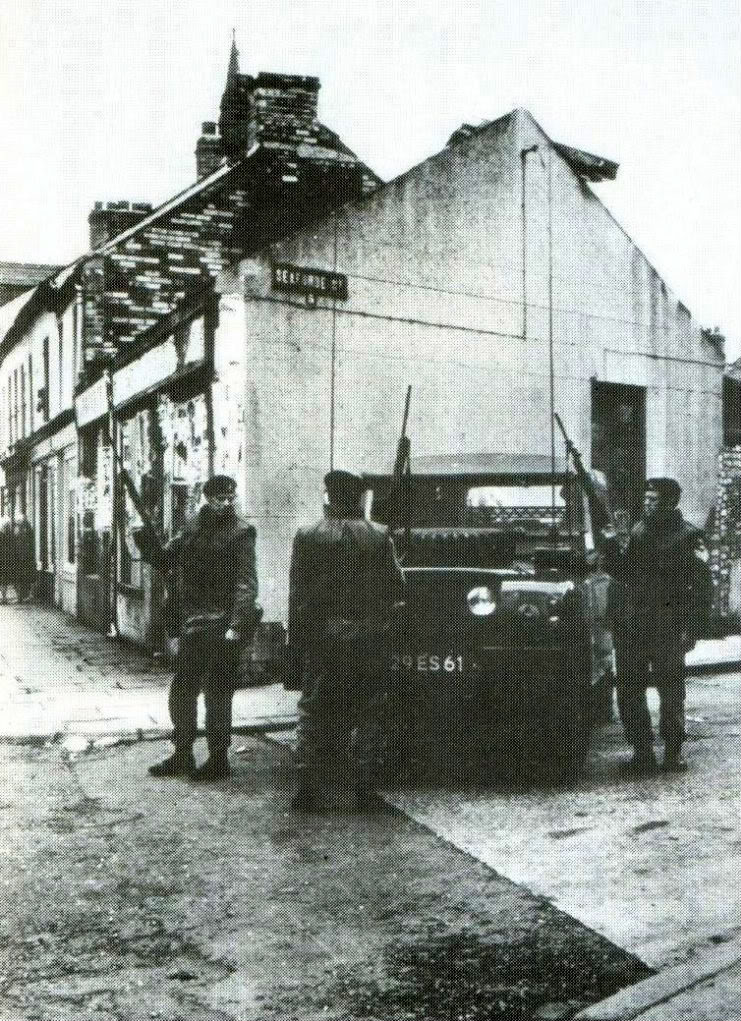
British soldiers at the entrance to Seaforde Street in the aftermath of the battle – too late to prevent the loss of life and destruction of property
His lack of humanity in the use of the British Army in the Lower Falls just one week later has been recorded elsewhere (Law (?) and Orders, by Seán Óg Ó Fearghail published by Central Citizens’ Defence Committee), and adds to the strength of our judgement that General Freeland is assured of a place in the pages of Irish history.
5. Sir Robert Porter, then Minister of Home Affairs, misled the House of Commons, Stormont, on Tuesday 30th June.
6. Dr Ian Paisley misled the House of Commons, Stormont, on Tuesday 30th June.
7. Dr Ian Paisley misled the House of Commons, Westminster, on Friday 3rd July.
8. The parishioners of St Matthew’s were justified in law, both moral and legal, in having the church complex defended against a continuous attack by both gunfire and petrol-bomb.
Our story is nearly finished. As we look back with admiration at the history of this proud parish, our prayers go out for all those who have died in its vicinity by violence, Catholic and Protestant alike, for we believe, as the Bishops said in their statement in August 1969, “that Protestants in general are good Christian people” – but as many of them are cruelly misled by vicious anti-Catholic propaganda.
This has been a part-history of St Matthew’s parish and perhaps it is appropriate that we should end with St Matthew:
“For I was hungry and you gave me no food,
I was thirsty and you gave me no drink,
I was a stranger and you did not welcome me,
Naked and you did not clothe me,
Sick and in prison and you did not visit me.
Then they also will answer, ‘Lord when did we see thee hungry or thirsty or a stranger or naked or sick or in prison and did not minister to thee?’
Then he will answer them ‘Truly, I say to you, as you did it not to one of the least of these, you did it not to me.’”
Our Divine Lord in becoming man bound the whole human race to Himself as a family through a supernatural solidarity and chose so to identify Himself with men that He takes as done to Himself, in hurt or in love, whatever we do to our fellow-men even the least. Let us extend the hand of friendship and in the words of the Catholic Bishops’ statement of August 1969 “commence the rebuilding of community relations with Christian faith and hope.”
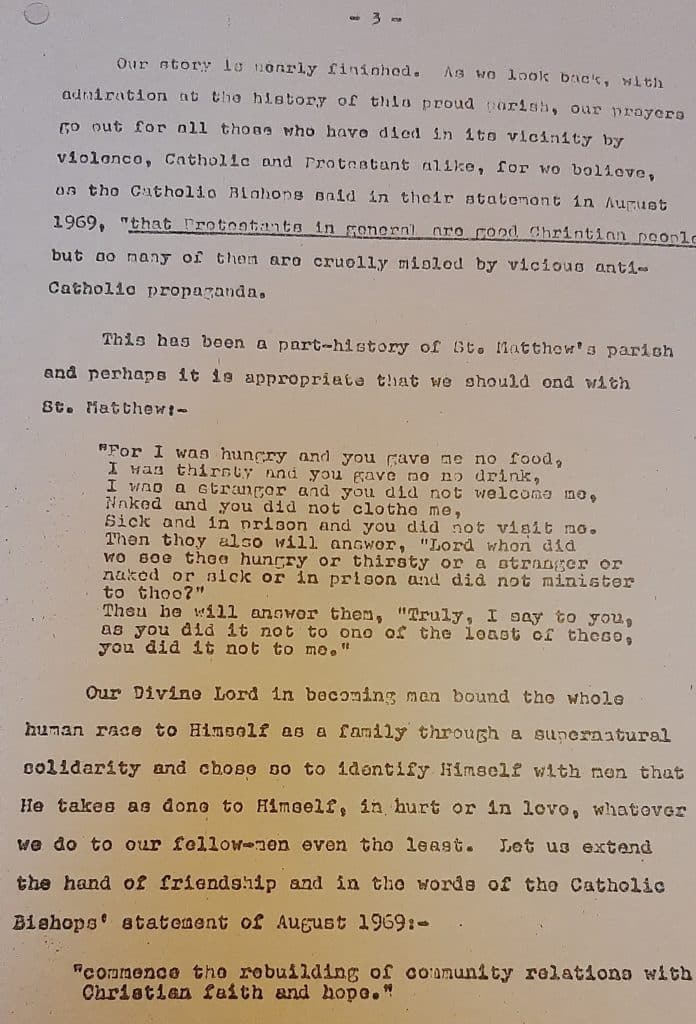
The last page of the manuscript.